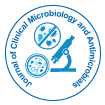
Journal of Clinical Microbiology and Antimicrobials
Open Access
+44-77-2385-9429

+44-77-2385-9429
Commentary - (2023)Volume 7, Issue 2
Bacteriology, a branch of microbiology, is the scientific study of bacteria. Bacteria are single-celled microorganisms that can be found in virtually every environment on Earth, from the depths of the ocean to the soil beneath our feet. Despite their microscopic size, bacteria play a crucial role in shaping the living world and have a significant impact on human health, the environment, and various industries. This article discusses about the captivating field of bacteriology and explore the diverse aspects of bacteria.
History of bacteriology
The origins of bacteriology can be traced back to the seventeenth century when the first observations of microorganisms were made by scientists such as Antonie van Leeuwenhoek, who built the first microscope capable of visualizing bacteria. However, it was not until the nineteenth century that bacteriology emerged as a distinct scientific discipline with the pioneering work of Louis Pasteur and Robert Koch. Pasteur's experiments on fermentation and Koch's development of pure culture techniques laid the foundation for the study of bacteria and their role in disease.
Characteristics of bacteria
Bacteria are prokaryotic organisms, meaning they lack a nucleus and other membrane-bound organelles. They come in various shapes, including cocci (spherical), bacilli (rod-shaped), and spirilla (spiral-shaped). Bacteria exhibit an astonishing diversity of metabolic capabilities, enabling them to thrive in diverse environments. Some bacteria are autotrophic, capable of synthesizing their own organic compounds from inorganic sources, while others are heterotrophic, relying on external organic sources for nutrition.
Importance of bacteria
Bacteria have a profound impact on various aspects of life. They play a crucial role in the environment, where they participate in nutrient cycling and degradation of organic matter. Bacteria are also involved in nitrogen fixation, converting atmospheric nitrogen into forms that can be used by plants. Without these microbial processes, life on earth would be impossible.
In addition to their environmental significance, bacteria have both positive and negative effects on human health. Some bacteria form symbiotic relationships with humans, residing in the gut and aiding in digestion and the synthesis of vitamins.
Applications in industry
Bacteria have found numerous applications in various industries. One notable example is the production of antibiotics. Antibiotics are compounds produced by certain bacteria that inhibit the growth of or kill other bacteria. These medicines have revolutionized modern medicine and saved countless lives. Bacteria also play a crucial role in the field of biotechnology, where they are used in the production of enzymes, pharmaceuticals, and biofuels. Genetic engineering techniques allow scientists to modify bacteria to produce specific substances of interest.
Diagnostic techniques
Bacteriology employs a range of diagnostic techniques to identify and characterize bacteria. Microscopy techniques, such as Gram staining, enable the visualization of bacterial cells and the determination of their cell wall composition. Culture-based techniques involve growing bacteria on selective media to obtain pure cultures that can be further analyzed. Molecular techniques, such as Polymerase Chain Reaction (PCR), allow for the detection and identification of bacteria based on their DNA or RNA.
Emerging trends and future directions
Bacteriology continues to evolve as new techniques and technologies emerge. Metagenomics, for instance, allows the study of entire bacterial communities present in a given sample, providing insights into complex microbial ecosystems. Additionally, the field of synthetic biology aims to engineer bacteria with novel properties and functions, paving the way for advancements in medicine, energy production, and environmental remediation.
Furthermore, the rise of antimicrobial resistance poses a significant challenge to public health.
Bacteria can acquire genetic mutations or exchange genetic material, leading to the development of resistance against antibiotics.
Studying the mechanisms of antibiotic resistance and developing new strategies to combat it are critical tasks in bacteriology.
Citation: Truls N (2023) Bacteriology: Characteristics, Diagnostics and Applications of Bacteria. J Clin Microbiol Antimicrob. 7:158.
Received: 02-Jun-2023, Manuscript No. JCMA-23-25524; Editor assigned: 06-Jun-2023, Pre QC No. JCMA-23-25524 (PQ); Reviewed: 20-Jun-2023, QC No. JCMA-23-25524; Revised: 28-Jun-2023, Manuscript No. JCMA-23-25524 (R); Published: 06-Jul-2023 , DOI: 10.35248/JCMA.23.7.158
Copyright: © 2023 Truls N. This is an open-access article distributed under the terms of the Creative Commons Attribution License, which permits unrestricted use, distribution, and reproduction in any medium, provided the original author and source are credited.